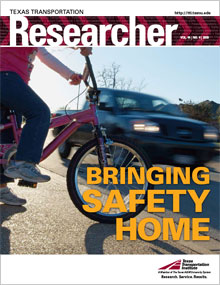Helping motorists reduce speeds near schools

SCHOOL SPEED LIMIT 20. That’s one sign we’re all likely to pay attention to. But those who don’t may potentially put children at risk.
Some may think that making school speed zones longer is the answer. Or maybe it’s flashing lights or a lower speed limit. To find the answers, the Texas Transportation Institute (TTI) conducted a two-year research project for the Texas Department of Transportation (TxDOT).
“We took a closer look at how and where TxDOT installs school speed zones,” says Kay Fitzpatrick, TTI senior research engineer. “We looked at what the different TxDOT districts were doing, as well as what other states were doing.”
Researchers also gathered speed data at 22 sites in Texas. They used the data to create relationships among the posted speed of the school zone, the length of the school zone, the amount of time the school zone was active and the actual speed of vehicles in the school zone.
The research team evaluated the various techniques and developed guidelines for traffic control near schools. “The guidelines give us more detail on what devices and techniques work best for school zones,” says Omar Madrid, the TxDOT project director. “It will help us make school zones uniform and provide guidance for more effective traffic control designs.”
For example, transportation agencies may feel local pressure to install more speed zones around schools, or to extend the speed zones over a longer area or time period. These approaches may not be the most effective techniques, however.
“Now we have research that says speeds increase as you drive through the school zone,” says Fitzpatrick. “If you have a 1,000-foot school zone, that doesn’t mean you will have the same speed throughout the entire 1,000 feet.”
Research showed that average speeds increase one mile per hour for every
500 feet driven. A longer school zone would produce more variability in actual driving speeds. School zones may not even be necessary if there are already signalized intersections or stop signs in place to stop traffic so school children can cross the street. The research also showed that the “buffer zone” is unique to Texas. The buffer zone begins with a school warning sign and ends with the school speed limit sign, transitioning into the actual school speed zone. The guidelines give more definition for the use of these buffer zones.
With solid research behind the guidelines, transportation agencies now have better arguments for why we should manage the length and time that the school speed zone is active. Better school speed zones should equal more people obeying the warning signs, meaning better safety for adults and children in the area.
